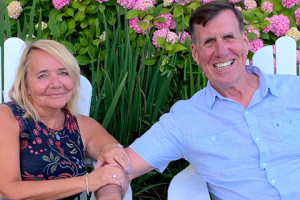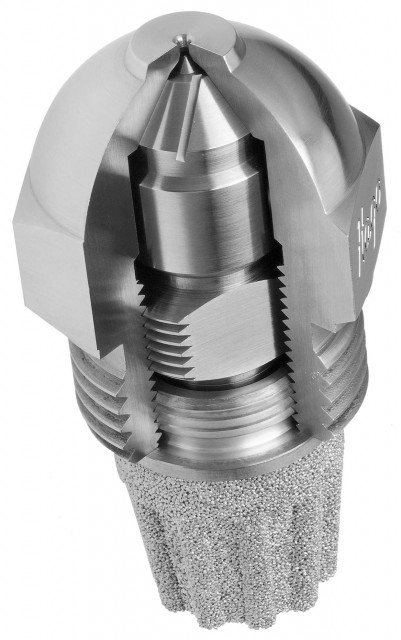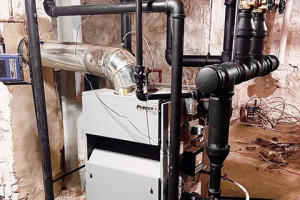
Hello, old friend. I’m writing today to say thanks, and to say farewell. This will be my last column.

“Magazine Man!” he shouted and then grabbed me by the shoulders and shook me like a gallon of old paint. "Welcome!” he bellowed. “Now, we make a nozzle? Yes?" I nodded. He let go of me, gave me a thumbs-up as though we were about to leave for the moon, and then, for the next four hours, I watched in wonder, came back and wrote about it.
My friend, Bill Boss, who has worked for Danfoss since the early ‘70s, was with me that day. He and I have remembered, and laughed about The Nozzle Man many times since then. Passionate people are impossible to forget. Bill called last winter. “I’ve got a new guy for you to meet.”
So I drove to Mountainside, New Jersey on a cold day last January and met Production Man. There was a crew installing new windows on the ‘50s-style building when I drove up. This is a building that has grown like a Transformers toy over the years. There are brick walls inside that used to be outside, but that’s normal for such buildings. Grow and expand. Build for the needs of production. Build for flow. Focus on perfection. Focus on customers. Good windows are an afterthought, but from the looks of those single-panes, it was time.
Andrew Kozdron has a title: Production Manager, Heating Solutions, Division of Danfoss LLC. He moves through the old factory like a point guard. I ask about the building, why it’s where it is, who started all of this, where the name came from.
They’re making nozzles for oil burners in this building, very similar to the ones Knud Mölholm made in Denmark, but here, they also make nozzles for fire-suppression systems that spray mists of water at 1,400-psig pressure to extinguish fires on ships and in European buildings. We have no such systems in the U.S. This system puts out the fire without drenching the building.
“These nozzles must be perfect, Andrew Kozdron, Production Man, tells me. The first indication of a failure would be that the building or the ship burned down.
“That’s not acceptable. There is absolutely no allowance for error when we make these,” he says, handing me one. It looks like a Swiss watch. “This is a life-and-death issue. We must be perfect every time. There’s no margin for error.” He looks me hard in the eye. He needs for me to understand that. He waits.
I believe him.
Danfoss bought the Hago brand in 2006. Hago’s name comes from the marriage of the names of brothers-in-law, Hermann Harsch and Ludwig Goetz, two industrial machinists who saw opportunity with the growth of the oil-heat business in 1937. They set up shop in Newark, New Jersey, grew like corn, and moved into the building that would also grow and spread out, and now needed new windows.
Here is some of what I thought of as I watched and learned from Production Man:
Nozzles are not commodities, even though they appear to be commodities. The oil burner nozzles come in boxes, like eggs, and we never stop to think much about them; but then we rarely think much about the wonder of eggs either, do we?
These nozzles come in small, plastic containers, each with a cap that shows the flow rate, shape and angle of the flame to be. They fit nicely into a box, like eggs. Ho hum.
Andrew Kozdron, Production Man, grabs one of those small, plastic containers from the hopper. He presses on a cap. “You see that?” he asks. “How tightly that snaps on? You hear that? That matters. We could buy these containers from a lot of places, and we could buy them cheaply. It’s a throwaway item. But what if the container was cheap and flimsy? The cap would probably fall off in our customer’s toolbox. That could damage the nozzle. I don’t ever want that to happen, so we pay more and we buy them locally from a company that I trust. I can go and see those people. I pay as much attention to these containers as I do to the steel we use to make the nozzles. Every detail matters.”
So he tells me about the steel and he shows me the bundles. “It’s special steel,” he says. “It has to be for this service.” He touches a bundle of steel rods like you might touch a ’64 Mustang. “We can trace any nozzle that leaves this building back to the bundle of steel that it came from,” he says. He picks up the paperwork and shows me how it all works. “If there’s ever a problem, I will know exactly where that problem came from and I will know what caused it. This is the way we do everything here.”
Some more of what I thought:
Nozzles are cheap. You can get them for a couple of bucks. But then, as I did in Denmark years ago, I watch them being born. The steel is indeed special. It has to be because a nozzle has so many surfaces, and each surface must be just right if the flame is to swirl properly and burn cleanly, and if the water is to put out the fire in the building or on the ship. There’s intricate machining on the inside and the outside of each nozzle. Every cut and bevel matters.
And have you ever considered the size of the hole in an oil-burner’s nozzle? Take a close look when you have a moment. That hole is not just tiny; it’s also machined with specific, microscopic bevels that launch and spin the flame, making it dance like a ballerina.
“Look at this tool,” Production Man says, handing me a sliver of steel a quarter the length of a sewing needle. “Can you see the cutting edge?” I look more closely but my eyes are not good enough. “Put it here,” he says, moving me over to a lighted magnifying glass. I do. I turn it and find the right magnification, and then I gasp at what I’m seeing. The edge, which is miniscule, is also flat and sharp. It’s like looking at a grain of machined pepper.”
“There’s a blueprint of it on the wall. You can see how it is there.”
“Where the heck does this come from?” I ask.
“We make them here,” he says. “We make everything here. It’s the only way to get it right.” He gestures for me to follow and moves quickly. He points at a steel part underneath a machine. “See this? I could buy that part, probably for about sixteen-hundred dollars, but it wouldn’t be as stable as what we built here. And if it’s not stable, the product won’t be perfect.” He looks at me. Again, he needs for me to understand this.
I get it.
“We test each nozzle for its spray pattern with special oil that we developed. There is nothing we could buy that would work as well as this oil for testing the flame pattern.” He shows me the clear oil in action as a woman who has done this testing for many years works. She smiles at me and nods. Confidence.
Production Man puts some of the oil on my hand. “It has to be perfect.”
I follow him for hours. He explains every process, shows me every tool and product, gets crazy excited about it all and does everything except shake me like a can of old paint. I love every minute.
Andrew Kozdron, Production Man, came to this business by way of the automotive- and pharmaceutical industries. He makes me see the world in a new way, as did that passionate Nozzle Man in Denmark. Something as simple as a nozzle is really not so simple. It is beautiful, elegant, and highly engineered, and if you ever get a chance to go see, then go see.
“How does a guy move from automotive to drugs to this?” I ask.
He smiles. “It’s all production,” he says. “It’s what I do.”
“What are your hobbies?”
He laughs and answers quickly. “Cars, fishing and soccer.”
I smile and think about the intricate mechanical nature of cars, the patience, belief and knowledge required for fishing, and the teamwork and skills that define good soccer.
“Perfect,” I say.
I drive back to Long Island, noticing the cars on the road, the way the toll plaza works, the metal latticework of the George Washington Bridge, the ever-changing Manhattan skyline, the granite walls that yielded to the Cross Bronx Expressway, all these things that we take for granted. I notice them because of Andrew Kozdron.
Passionate people are impossible to forget.


Hello, old friend. I’m writing today to say thanks, and to say farewell. This will be my last column.

My six-year-old grandboy, Brendan, was in the vestibule of the diner when the bubblegum machine caught his attention. It was one of those spiral models that appeared in t...

Subdural posed a question on The Wall at HeatingHelp.com in the Strictly Steam section, where some of the sharpest knives in the drawer post every day. The question was a...